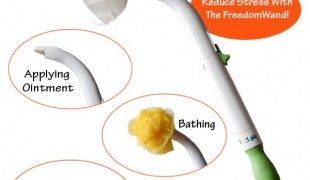- 4743
- 248
- 5
- 3
- 0
- Help Ukraine
About the solution
“The defining moment was when I was sitting on a toilet seat trying to figure out what I could possibly use to support some portion of my weight and lessen the severe weight bearing pain in my knees after a day of snowboarding 30,000 vertical feet on double black diamond moguls. You see, I have spent a lifetime enjoying extreme sports and I have the knee surgery scars to prove it. When I lowered to the toilet seat that day it was painful, but from experience I knew that raising was always more painful. In the end, the only thing I could find for support was the front of the toilet seat. Wingman was as much for my father as it is today for me. It was after I had seen that he (at age 87) had worn the paint off his toilet seat with his palms supporting himself while lowering and raising that I designed a toilet seat with wings – Wingman”, the innovator explained.
When Stephen realized he had this need, he started prototyping. “The first prototype was easy. It only took a few months to create a 3D model and print it out in ABS plastic with a 3D printer. The follow on prototypes required careful material selection for strength, safety, ease of molding and then the creation of hard tooling. This process has taken a couple of years. The single most important problem was realizing that to achieve the strength required the seat was heavy and to prevent it from coming down to hard it required a dampening device or torsion spring to lessen the weight when lowering or raising”, he said.
Then, using his savings, the inventor founded his own company – Wingman.
Adapted from: http://bit.ly/2n4LZpa
More info: http://axs-wingman.com/Home_OYQ4.html
What about you, do you have any solutions? Please share them with the Patient Innovation community!
https://www.youtube.com/watch?v=X6UL9PSi-UU
This solution shall not include mention to the use of drugs, chemicals or biologicals (including food); invasive devices; offensive, commercial or inherently dangerous content. This solution was not medically validated. Proceed with caution! If you have any doubts, please consult with a health professional.
DISCLAIMER: This story was written by someone who is not the author of the solution, therefore please be advised that, although it was written with the utmost respect for the innovation and the innovator, there can be some incorrect statements. If you find any errors please contact the patient Innovation team via info@patient-innovation.com
-
-
296
-
0
-
4802

Device to help get out of the car
Grip
STANDING UP: Standing up from a seated position
Arthritis
Muscle Tone Abnormalities weakness
3d Printed
Assistive Daily Life Device (to help ADL)
Difficulty walking or moving
Muscle weakness
Limited range of motion
Muscle pain or stiffness
Loss of muscle coordination
Muscle cramps or spasms
Joint redness or warmth
Swelling or inflammation
Difficulty standing from a seated position
Back pain
Joint pain or swelling
Restoring mobility
Managing pain
Caregiving Support
General and Family Medicine
Neurology
Orthopedics
Public Health
Rheumatology
Aging
Mobility issues
Belgium
-
-
-
467
-
0
-
6871

FreedomWand Personal Hygiene & Toilet Aid
(SELF)-CARE: HYGIENE: Maintaining personal hygiene
(SELF)-CARE: USING THE TOILET: Using the toilet independently
Bone Disorders (Decalcification, Bone Deformity, Bone Fracture, Bone Infection)
Neuromuscular Disorders
Spinal Cord and Nerve Root Disorders
Cervical spinal cord injury/Tetraplegia
Assistive Daily Life Device (to help ADL)
Difficulty walking or moving
Muscle weakness
Difficulty coordinating movements
Stiffness or rigidity (difficulty moving)
Paralysis of the legs and lower body
Limited range of motion
Muscle pain or stiffness
Difficulty bearing weight
Difficulty standing from a seated position
Back pain
Promoting self-management
Caregiving Support
General and Family Medicine
General Surgery
Neurology
Orthopedics
Rheumatology
United States
-
-
-
330
-
0
-
5270

Open back adaptive slacks (from slacks without elastic waist bands)
(SELF)-CARE: DRESSING: Dressing independently.
(SELF)-CARE: USING THE TOILET: Using the toilet independently
Amyotrophic Lateral Sclerosis
Body-Worn solutions (Clothing, accessories, shoes, sensors...)
Gait abnormalities (e.g., walking difficulties, unsteady gait)
Tremors
Muscle cramps or spasms
Difficulty coordinating movements
Stiffness or rigidity (difficulty moving)
Paralysis of the legs and lower body
Muscle weakness
Loss of balance
Trouble with fine motor skills (e.g., writing, buttoning clothes)
Numbness or tingling in the extremities
Twitching or involuntary movements (myoclonus)
Dizziness or lightheadedness
Fatigue
Restoring mobility
Promoting self-management
Rehabilitating After Stroke
Managing Neurological Disorders
Caregiving Support
General and Family Medicine
Internal Medicine
Neurology
Orthopedics
Pediatrics
Rheumatology
United States
-
 en
en